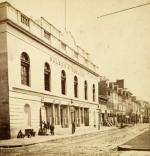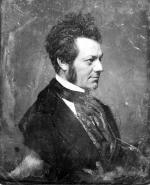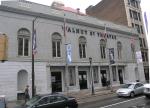![header=[Marker Text] body=[Founded in 1809, this is the oldest playhouse in continuous use in the English-speaking world and a National Historic Landmark. As America's oldest theatre, many of the world's greatest actors and actresses have appeared on stage here.] sign](http://explorepahistory.com/kora/files/1/10/1-A-256-139-ExplorePAHistory-a0h7v5-a_450.jpg)
Mouse over for marker text
Name:
Walnut Street Theatre
Region:
Philadelphia and its Countryside/Lehigh Valley
County:
Philadelphia
Marker Location:
9th and Walnut Sts., Philadelphia
Dedication Date:
September 25, 1996
Behind the Marker
As theater, it was riveting, historic, and utterly, utterly absurd. Live from the stage of Philadelphia's Walnut Street Theater, broadcast via television into homes from coast to coast, there was the President of the United States, Gerald Ford, standing silent and motionless for twenty-seven excruciatingly memorable minutes behind a podium just fifteen feet from Jimmy Carter, the man, standing just as silent and just as motionless, running to unseat him. "It was embarrassing to me," recalled President Carter some years later, "that both President Ford and I stood there almost like robots."
It was the night of Sept. 23, 1976, and for the first time since the landmark 1960 debates between John F. Kennedy and Richard Nixon -and the first time ever for an incumbent president - the Democratic and Republican candidates for the highest office in the land were meeting face to face to discuss the issues. But when they walked onto the stage, gremlins must have walked on with them; during the broadcast, the audio went dead. Not sure what to do, both candidates did nothing - quite literally - until the problem was fixed nearly half an hour later. As President Ford explained, "Both of us were hesitant to make any gesture that might look like we weren't physically or mentally able to handle a problem like this." Their hesitancy - and inertness - was remembered long after what they said that night. It made for unforgettable, and unscripted, political theater. And just another remarkable moment in the remarkable story of America's oldest continuously operating playhouse.
That story begins in 1809, with the opening on this spot of The New Circus as a showcase for the popular equestrian entertainments of the day. Within two years, though, the New Circus was old news; a stage was added for theatrical performances, the building was rechristened The Olympic, and its first play - Sheridan's The Rivals - opened with both the Marquis de Lafayette, French hero of the American Revolution, and former President Thomas Jefferson in the audience.
Soon, there were more changes - and innovations. The theater first adopted the Walnut Street name in 1820, the year that Edwin Forrest, America's first important home-grown tragedian, made his professional debut on its stage, but the name soon reverted to the Olympic, and the theater was recast as a circus for six years. Finally, in 1828, after major renovations inside and out, the Walnut Street name - and its role as legitimate theater - became permanent. Within a decade it became the first theater in the world to replace candles with gas footlights; by the mid-1850s, it became the first theater in the world to install an early version of air-conditioning.
Edwin Forrest, America's first important home-grown tragedian, made his professional debut on its stage, but the name soon reverted to the Olympic, and the theater was recast as a circus for six years. Finally, in 1828, after major renovations inside and out, the Walnut Street name - and its role as legitimate theater - became permanent. Within a decade it became the first theater in the world to replace candles with gas footlights; by the mid-1850s, it became the first theater in the world to install an early version of air-conditioning.
Over time, virtually every major actor of the nineteenth century and a galaxy of stars from the twentieth would see his or her name on the theater's marquee. The long list includes Edwin Booth (the nineteenth-century Shakespearean actor and brother of Lincoln assassin John Wilkes Booth once co-owned and managed the venue), Houdini, the Marx Brothers, Helen Hayes, George M. Cohan, Ethel Waters, Marlon Brando, Jessica Tandy, Katharine Hepburn, Audrey Hepburn, Jack Lemmon, Henry Fonda, and Sidney Poitier.
Much of that star power arrived with a change of ownership in 1941. While the theater had changed hands several times before the New York-based Shubert Organization bought it that year, none matched the Shubert's legacy. One of Broadway's premiere producing entities, the Shuberts reconceived Walnut Street as a venue for trying out and tweaking works-in-progress on the road to the Great White Way. A Streetcar Named Desire with Brando and Tandy, Mr. Roberts with Fonda and Lemmon, Gigi, The Diary of Ann Frank, A Raisin in the Sun with Poitier, and A Man for All Seasons are just some of the classic dramas that worked out their kinks on Walnut Street before the Shuberts sold the theater in 1969.
After another remodel (this one restored the elegantly ornate 1828 façade), the new owners tried to turn Walnut Street into a performing arts center that imported others" productions - in opera, dance, and music, and one presidential debate, as well as theater - instead of creating its own. The attempt fell flat. In the early 1980s, Walnut Street almost went dark.
But a group of community leaders banded together to save it. They succeeded by bringing in a new executive director, Bernard Havard, who convinced them that the theater's future could be found in its past: producing its own plays.
Today, Walnut Street remains a vital part of Philadelphia culture, thriving with a main stage; a second smaller, more intimate studio theater; and a theater school. Designated a National Historic Landmark in 1964, the Walnut Street since 1983 has mounted more than 150 productions, including several world and American premieres, and is now the most subscribed-to theater in the world.
It was the night of Sept. 23, 1976, and for the first time since the landmark 1960 debates between John F. Kennedy and Richard Nixon -and the first time ever for an incumbent president - the Democratic and Republican candidates for the highest office in the land were meeting face to face to discuss the issues. But when they walked onto the stage, gremlins must have walked on with them; during the broadcast, the audio went dead. Not sure what to do, both candidates did nothing - quite literally - until the problem was fixed nearly half an hour later. As President Ford explained, "Both of us were hesitant to make any gesture that might look like we weren't physically or mentally able to handle a problem like this." Their hesitancy - and inertness - was remembered long after what they said that night. It made for unforgettable, and unscripted, political theater. And just another remarkable moment in the remarkable story of America's oldest continuously operating playhouse.
That story begins in 1809, with the opening on this spot of The New Circus as a showcase for the popular equestrian entertainments of the day. Within two years, though, the New Circus was old news; a stage was added for theatrical performances, the building was rechristened The Olympic, and its first play - Sheridan's The Rivals - opened with both the Marquis de Lafayette, French hero of the American Revolution, and former President Thomas Jefferson in the audience.
Soon, there were more changes - and innovations. The theater first adopted the Walnut Street name in 1820, the year that
Over time, virtually every major actor of the nineteenth century and a galaxy of stars from the twentieth would see his or her name on the theater's marquee. The long list includes Edwin Booth (the nineteenth-century Shakespearean actor and brother of Lincoln assassin John Wilkes Booth once co-owned and managed the venue), Houdini, the Marx Brothers, Helen Hayes, George M. Cohan, Ethel Waters, Marlon Brando, Jessica Tandy, Katharine Hepburn, Audrey Hepburn, Jack Lemmon, Henry Fonda, and Sidney Poitier.
Much of that star power arrived with a change of ownership in 1941. While the theater had changed hands several times before the New York-based Shubert Organization bought it that year, none matched the Shubert's legacy. One of Broadway's premiere producing entities, the Shuberts reconceived Walnut Street as a venue for trying out and tweaking works-in-progress on the road to the Great White Way. A Streetcar Named Desire with Brando and Tandy, Mr. Roberts with Fonda and Lemmon, Gigi, The Diary of Ann Frank, A Raisin in the Sun with Poitier, and A Man for All Seasons are just some of the classic dramas that worked out their kinks on Walnut Street before the Shuberts sold the theater in 1969.
After another remodel (this one restored the elegantly ornate 1828 façade), the new owners tried to turn Walnut Street into a performing arts center that imported others" productions - in opera, dance, and music, and one presidential debate, as well as theater - instead of creating its own. The attempt fell flat. In the early 1980s, Walnut Street almost went dark.
But a group of community leaders banded together to save it. They succeeded by bringing in a new executive director, Bernard Havard, who convinced them that the theater's future could be found in its past: producing its own plays.
Today, Walnut Street remains a vital part of Philadelphia culture, thriving with a main stage; a second smaller, more intimate studio theater; and a theater school. Designated a National Historic Landmark in 1964, the Walnut Street since 1983 has mounted more than 150 productions, including several world and American premieres, and is now the most subscribed-to theater in the world.
Beyond the Marker








